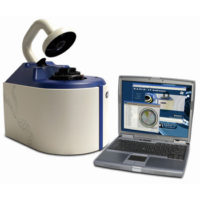About 40,000 cases of Salmonella poisoning are reported in the United States each year. Of these cases, approximately 400 people die.[1] Food producers need to protect themselves by ensuring that processed and prepared foods are not contaminated with Salmonella. They need to be able to detect Salmonella earlier and, in many cases, increase the quantity of testing without sacrificing sensitivity or specificity. Meeting both technical and budget requirements can be very challenging.
To enable faster, less expensive testing without sacrificing quality, Idaho Technology developed the Salmonella Food Security System (FSS), a PCR-based detection method that rapidly and specifically identifies Salmonella species in food. The system consists of the R.A.P.I.D.® LT thermocycler and the AOAC-approved Salmonella LT test kit. Thermocycling takes only 35 minutes, and the entire procedure takes 17 hours. The method involves a 16-hour sample enrichment, mechanical lysis to release DNA, DNA amplification (PCR), internal amplification controls, and automatic result interpretation by software. Samples can be tested individually or pooled for an increased throughput. The system may also be used and is AOAC approved with the Matrix MicroScience Pathatrix, a magnetic bead-based technology used to selectively bind Salmonella in the presence of complex matrices.
The FSS is approved for both single and pooled samples. Post-enrichment sample pooling is an excellent way to increase throughput and decrease costs for mostly negative samples. It is cost efficient when more than 90% of samples are negative. In this pooling scheme, samples are individually enriched and then pooled into a composite sample. The composite sample is then tested in the same way as an individual sample. If the composite sample is called positive, the individually enriched samples may be tested to determine which of those samples is positive. This process takes less than an hour due to the short 35-minute PCR run.
To qualify for AOAC approval, the system was evaluated for sensitivity, specificity, ruggedness, and stability of reagents. Three food types were used—ham, chicken, and chocolate—and test results were compared to reference methods. Each food type was divided into two portions: one portion of the food type was not inoculated, and the second portion was inoculated in a large batch so as to provide samples for testing by both the FSS and reference methods. Each food matrix was inoculated with a different Salmonella enterica serova, each chosen because they have been responsible for foodborne illness or associated with recent outbreaks: Salmonella Enteritidis with cooked ham; Salmonella Typhimurium with raw chicken; and Salmonella Senftenberg with chocolate. Testing was performed with both pooled samples (50 samples per food type combined in one container) and individual samples (25 samples per food type).
In both individual and pooled samples with and without the Pathatrix, the FSS demonstrated 100% sensitivity and 100% specificity for the three different food types. It also proved to be robust and reproducible. The ruggedness study demonstrated that the system produced consistent results even with variability in reagent preparation time and pipetted sample volumes. Lot-to-lot and shelf-life studies demonstrated consistent results with several lots of reagents produced at different times.
This system represents a significant improvement over standard methods in a number of ways:
• It is significantly faster, providing results in about 17 hours as opposed to 72 hours for the USDA and FDA BAM methods,[2, 3] and can perform real-time PCR and provide automated results in 35 minutes after enrichment and sample processing.
• It is equivalent to current USDA and FDA BAM official methods used to detect low levels of Salmonella in food (the system can detect a single bacterium in a 25-gram food sample).
• Pooling samples yielded the same results as individual samples and demonstrated no false positives or false negatives. Pooling enables more testing at less cost.
• The system is easy to use, with fewer steps and minimal sample handling.
This method promises to help food producers improve the quality and quantity of testing to protect their companies and their consumers from Salmonella contamination.
www.idahotechnology.com
References
1. www.cdc.gov/nczved/dfbmd/disease_listing/salmonellosis_gi.html#8
2. www.cfsan.fda.gov/~ebam/bam-5.html
3. www.fsis.usda.gov/PDF/MLG_4_03.pdf
Rapid Salmonella Detection Using the R.A.P.I.D. LT Food Security System




